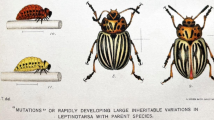Abstract
The genusRibes, 2n=16, consisting of over 150 shrubby species has been divided byRehder into 15 sections grouped into four subgenera. Data on interspecies crosses within and between these sections and subgenera made by previous workers and at East Malling are tabulated and discussed.
Species within a section are morphologically similar and will usually cross, forming fertile hybrids; 33 such hybrids in 6 of the 15 sections are known. Inter-sectional and inter-subgeneric crosses between more unlike species often fail, but matur flowering plants have been obtained from crosses involving the following combinations: −Symphocalyx x Calobotrya, Symphocalyx x Eucoreosma, Calobotrya x Eucoreosma, Eucoreosma x Heritiera, Eucoreosma x Ribesia, Eugrossularia x Robsonia, Euberisia x Eugrossularia, Symphocalyx x Eugrossularia, Calobotrya x Eugrossularia, Eucoreosma x Eugrossularia, andRibesia x Eugrossularia. Of these, only the combinationsEugrossularia x Robsonia andCalobotrya x Eucoreosma show any fertility.
On the basis of these results, it is suggested that a more natural classification ofRibes would be to retainRehder's subgeneraBerisia, Grossularia andGrossularioides, while creating from his sevenRibesia sections, six new subgenera, viz.Microsperma, Symphocalyx, Calobotrya (comprising the sectionsCalobotrya andEucoreosma), Cerophyllum, Heritiera, andRibesia. With this classification, in the light of present knowledge, all intra-sectional hybrids are fertile, intra-subgeneric hybrids at least partially fertile, and such inter-subgeneric hybrids as can be raised are sterile.
Similar content being viewed by others
References
Anderson, J. P. (1943). Two notable plant hybrids from Alaska.Proc. Ia Acad. Sci. 50: 155–157.
Anderson, M. M. &W. Fordyce (1960). Black currant breeding.Rep. Scott. hort. Res. Inst. 7: 15–16.
Anonymous (1934). “The plant resources of the world as initial material in plant breeding. Botanic-ecological and economic characteristics, V. Fruits and small fruits and their wild relatives”.Lenin Acad. Agric. Sci. Inst. Plant Ind. (Leningrad) 127 pp. (InPlant Breed. Abst. 5: 250–252).
Bauer, R. (1955). “Resistance problems in the genusRibes and possibilities of their solution by making intra-and inter-sectional crosses”.Rep. 14th int. hort. Congr. (Scheveningen): 685–696.
Berger, A. (1924). A taxonomic review of currants and gooseberries.N. Y. State Agric. Exp. Sta. Tech. Bull. 109: 118 pp.
Darlington, C. D. (1929). A comparative study of the chromosome complement inRibes.Genetica 11: 267–269.
Darrow, G. (1937). Improvement of currants and gooseberries.Yearb. Agric. U.S.D.A.: 534–544.
Himmelbaur, W. (1911). Notes on the life history ofRibes pallidum.Jb. Hamburg. wiss. Anst. 29: 151–245.
Hollingshead, L. (1930). A lethal factor inCrepis effective only in an interspecific hybrid.Genetics 15: 114–140.
Hunter, A. W. S. (1950). Small fruits: Gooseberries, Black currants.Progr. Rep. Cent. Exp. Fm. (Ottawa 1934–48: 26–30.
Janczewski, E. de (1907). “Monograph of the currantsRibes L.”Mem. Soc. Phys. et Hist. Nat. de Genève 35: 199–517.
Janczewski, E. de (1910). “Supplement to the monograph of currants. I. New species and hybrids”.Bull. int. Acad. Sci. Cracovie 1909B: 60–75.
Janczewski, E. de (1911). “Supplements to the monograph of currants, IV. New Hybrids”.Bull. int. Acad. Sci. Cracovie 1911B: 612–619.
Janczewski, E. de (1917). “A hybrid between a dioecious and a hermaphrodite currant”.Bull. int. Acad. Sci. Cracovie 1916B: 98–104.
Keep, E. (1958). Cytological notes.Rep. East Malling Res. Sta. 1957: 75–78.
Koehne, E. (1902).Ribes grossularia x nigrum (R. schneideri Maurer in litt.)Gartenflora 51: 409–411.
Kuzmin, A. J. (1938). “Some results of interspecific hybridization inRibes, Rubus andFragaria”. Bull. Acad. Sci. U.R.S.S. Ser. Biol.: 681–692.
Kuzmin, A. J. (1940). “The role of the intermediary plant in obtaining the first and second generation between black currant and gooseberry”.Proc. Lenin Acad. Sci. U.S.S.R. 5: 3–12.
Kuzmin, A. J. (1941). “The role of the intermediary in hybridizing currants with gooseberries”.Sovetskaja Botanika 1–2: 14–23.
Lorenz, P. (1929). “Hybridization in the genusRibes”.Züchter 1: 66–68.
MacFarlane, J. M. (1900). HybridRibes.Gardener's Chron. 28, Ser. 3: 7.
Meurman, O. (1928). Cytological studies in the genusRibes L.Hereditas 11: 289–356.
Nilsson, F. (1949). Polyploids inRibes, Fragaria, Raphanus andLactuca. Proc. VIII int. Congr. Genet. (Stockholm) (Suppl.Hereditas): 34–35.
Nilsson, F. (1951). “Interspecific hybrids and tetraploids within the genusRibes”.Nord. Jordbr. Forskn. 31–32: 418–424.
Nilsson, F. (1955). Amphidiploid species in the genusRibes. Rep. 14th int. hort. Congr. (Scheveningen): 697–711.
Nilsson, F. (1956). “Species hybrids in the genusRibes, subgenusCoreosma”.Bot. Notiser 109: 33–49.
Nilsson, F. (1959). Polyploidy in the genusRibes.Genetica Agraria 11: 225–242.
Pavlova, N. M. (1940). “Initial material for the breeding and cultivation of bush fruits”.Vestnik Socialističeskogo Rastenievodstva 5: 33–46.
Rehder, A. (1923).J. Arnold Arbor. 4: 113.
Rehder, A. (1954).Manual of cultivated trees and shrubs. MacMillan & Co., Toronto, 996 pp.
Rietsema, I. (1955). “Interspecific hybrids in the generaRibes andRubus”.Rep. 14th Int. hort. Congr. (Scheveningen): 712–715.
Sax, K. (1931). Chromosome numbers in the ligneous Saxifragaceae.J. Arnold Arbor. 12: 198–206.
Stebbing, G. L. (1958). The inviability, weakness, and sterility of interspecific hybrids.Adv. Genetics 9: 147–215.
Tolmačev, I. A. (1940). “An experiment on overcoming incompatibility”.Jarovizacija 5(32): 125–126. (InPlant Breed. Abst.11: 321.)
Tolmačev, I. A. (1941). “Hybrids of Crandall-currant with black currant”.Vestnik Gibridizacii 1: 115. (InPlant Breed. Abst. 12: 278.)
Tun, N. N. (1961).In “Pomology”by C. A. Wood.Rep. Scott. hort. Res. Instit.8: 17.
Tydeman, H. M. (1933). Fruit breeding.Rep. East Malling Res. Sta. 1932: 34.
Vaarama, A. (1948). A triple species hybrid in the genusRibes.Hereditas (Lund) 34: 369–370.
Vaarama, A. (1949). Spindle abnormalities and variation in chromosome number inRibes nigrum.Hereditas (Lund) 35: 136–162.
Vìksne, A. (1931). “Preliminary communication on crosses withRibes (1924–1931)”.Acta Hort. Bot. Univ. Latv. 6: 86–89.
Wilson, J. (1900). The structure of certain new hybrids (Passiflora, Albuca, Ribes, Begonia).J. Roy. Hort. Soc. 24: 146–180.
Zielinski, Q. B. (1953). Chromosome numbers and meiotic studies inRibes.Bot. Gaz. 114: 265–274.
Author information
Authors and Affiliations
Rights and permissions
About this article
Cite this article
Keep, E. Interspecific hybridization inRibes . Genetica 33, 1–23 (1963). https://doi.org/10.1007/BF01725743
Received:
Issue Date:
DOI: https://doi.org/10.1007/BF01725743




